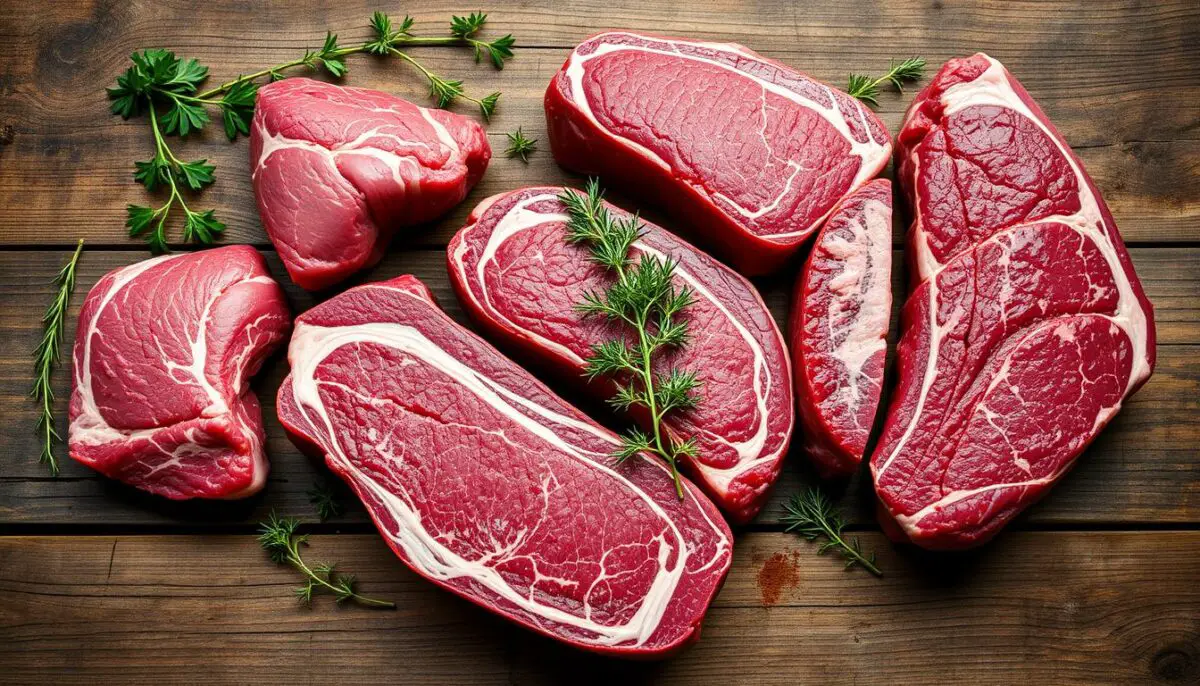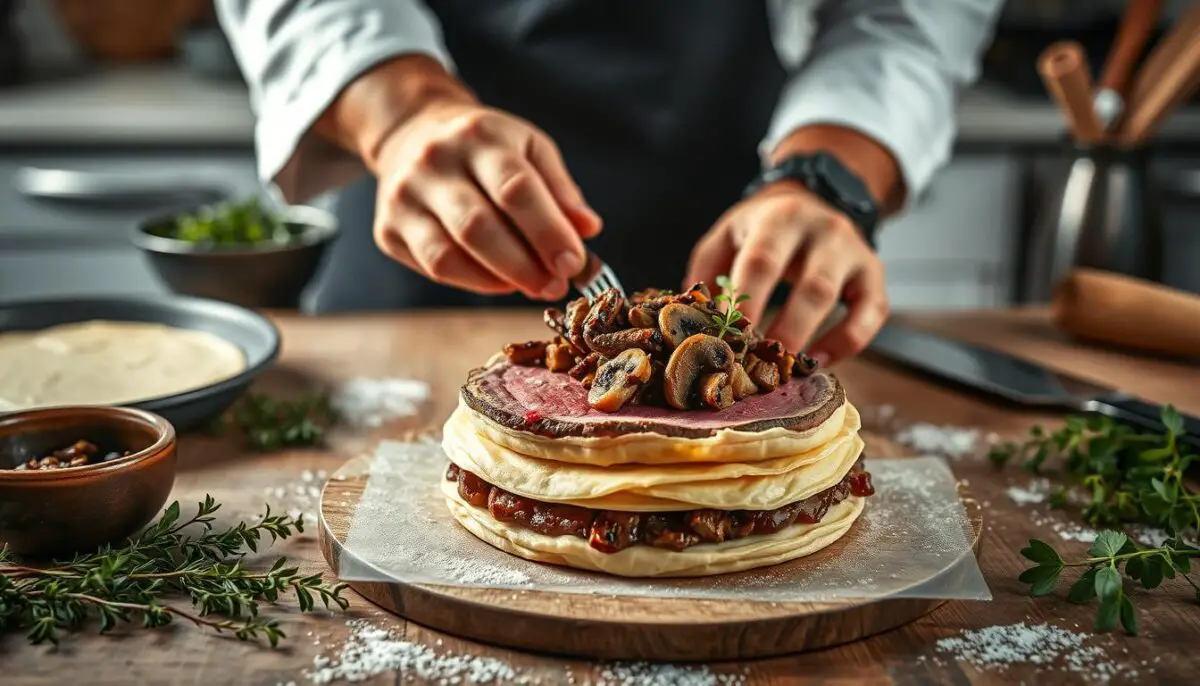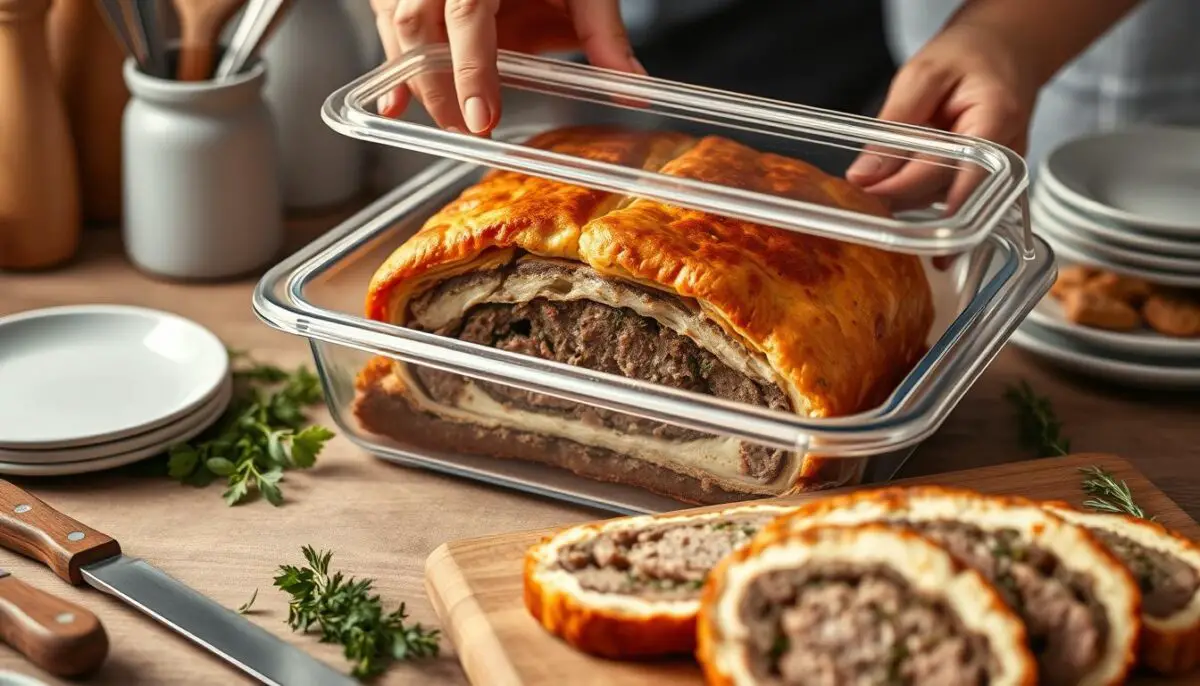Welcome to your guide on mastering Beef Wellington. This classic dish is a favorite at special occasions. We’ll explore its history and how it can make your meals unforgettable. Whether you’re a pro or a beginner, you’ll learn how to make this dish perfectly.
Key Takeaways
- Learn the history and significance of Beef Wellington in gourmet cooking.
- Master the essential ingredients, including the right cut of beef.
- Follow step-by-step preparation methods for a flawless result.
- Avoid common pitfalls to ensure a perfect masterpiece.
- Discover ideal sides and wine pairings to enhance your meal.
- Explore delicious variations to personalize your Beef Wellington.
Introduction to Beef Wellington
The history of Beef Wellington is as rich and layered as the dish itself. This iconic recipe is a staple of fine dining, known best in British cuisine. It dates back to the 19th century, linked to the Duke of Wellington and his love for grand meals.
The dish features a beef tenderloin wrapped in mushroom duxelles and pâté, all in a flaky pastry. Over time, Beef Wellington has seen many variations across cultures. It’s a favorite in fancy restaurants and homes, perfect for holidays and special events.
This dish’s ability to wow guests has made it a favorite among chefs and home cooks. Many families hold it dear, making it a key part of their celebrations and gatherings.
Essential Ingredients for Beef Wellington
Making a memorable Beef Wellington starts with top-notch ingredients. You need the right cuts of beef and fragrant herbs to boost the dish’s flavors. Choosing the right ingredients is key to a great cooking experience.
Choosing the Right Cut of Beef
The heart of Beef Wellington is the beef. The tenderloin is the top choice because it’s tender and flavorful. It makes the dish soft and tasty.
Other cuts like sirloin or ribeye can work too, but cooking times might vary. Look for beef with good marbling and freshness. It makes a big difference in taste.
Gathering Fresh Herbs and Spices
Fresh herbs are vital for Beef Wellington’s flavor. Thyme, rosemary, and parsley are favorites. They add unique smells and tastes that mix well with the beef.
Seasoning the mushroom duxelles with spices like pepper and nutmeg also helps. It brings out the mushroom’s earthy taste. Using fresh, quality herbs and spices makes your Beef Wellington special.
Step-by-Step Preparation of Beef Wellington
Making Beef Wellington starts with careful preparation. We’ll cover two key steps: preparing the beef tenderloin and making the mushroom duxelles. These steps are vital for a dish that’s both flavorful and tender, sure to wow your guests.
Preparing the Beef Tenderloin
Begin with a high-quality beef tenderloin for the best taste. It’s important to remove any excess fat or silverskin from the meat. This helps the meat cook evenly and boosts its flavor. Here are some tips for preparing the beef:
- Seasoning meat: Season the tenderloin with salt and pepper to bring out its natural taste.
- Creating a crust: Sear the meat in a hot skillet until it’s browned on all sides. This step keeps the meat moist and adds a nice crust.
- Resting: Let the beef rest after searing. This helps keep it juicy.
Making the Mushroom Duxelles
Mushroom duxelles adds a rich flavor to Beef Wellington. Use fresh mushrooms like cremini or shiitake for their deep taste. Here’s a simple recipe for the mushroom filling:
- Chopping: Chop the mushrooms, shallots, and herbs finely for a smooth texture.
- Cooking: Sauté the mixture in butter over medium heat. Cook until the mushrooms release their moisture and thicken, creating a rich filling.
- Flavoring: Add salt, pepper, and a pinch of nutmeg to enhance the mushroom’s earthy flavors.
Assembling the Beef Wellington
Assembling Beef Wellington needs careful attention and layering. This ensures each part adds to the dish’s greatness. Start by getting your ingredients ready. These include a beef tenderloin, mushroom duxelles, and optional prosciutto. Learning to layer steak and other parts makes the dish a hit at dinner.
Layering the Ingredients
Start by spreading mushroom duxelles on plastic wrap. This layer keeps the pastry dry. Then, add prosciutto for saltiness and richness. Place the seared beef in the middle, making sure it’s centered.
The secret to good layering is to handle the ingredients gently. This lets each layer’s flavor and look shine through.
Wrapping the Beef with Pastry
After layering, it’s time to use your pastry skills. Roll out the puff pastry evenly to avoid sogginess. Wrap the Wellington by folding the pastry over the ingredients, making sure it’s snug but not too tight.
Press the edges to seal well, trimming any extra pastry. Use a sharp knife to make decorative slashes on top. Brush the pastry with egg wash for a golden-brown finish.
| Layer | Purpose |
|---|---|
| Mushroom Duxelles | Moistens the beef and adds earthy flavor |
| Prosciutto | Adds richness and prevents the pastry from absorbing moisture |
| Beef Tenderloin | Serves as the star of the dish, providing a tender bite |
| Puff Pastry | Encases the ingredients and provides a flaky crust |
Cooking Techniques for Perfect Beef Wellington
To make perfect Beef Wellington, you need to get the timing and temperature right. Paying attention to these can make your dish tender and delicious. It’s all about the beef and the pastry working together.
Timing and Temperature Guidelines
When cooking Beef Wellington, the oven temperature is key. Heat it up to about 400°F (200°C). The baking time depends on the beef’s size and how rare you like it:
| Doneness Level | Internal Temperature (°F) | Approximate Baking Time |
|---|---|---|
| Rare | 120-125°F | 25-30 minutes |
| Medium Rare | 130-135°F | 30-35 minutes |
| Medium | 140-145°F | 35-40 minutes |
| Medium Well | 150-155°F | 40-45 minutes |
| Well Done | 160°F and above | 45-50 minutes |
Using a meat thermometer is a must. It helps you check the beef’s temperature without cutting it. Let the beef rest for 10-15 minutes after baking. This helps keep the juices in and makes the meat more flavorful.
Using a Meat Thermometer for Precision
A meat thermometer is a game-changer for Beef Wellington. Make sure it’s placed right and gives accurate readings. Regularly check your thermometer to ensure it’s working well.
Knowing the right internal temperatures for different doneness levels is key. This helps you plan and check the temperature without mistakes. Don’t rely only on time or open the oven too often. This can mess up your dish.
Common Mistakes to Avoid When Making Beef Wellington
Making a perfect Beef Wellington needs skill and focus. Many home cooks face mistakes in cooking that ruin their dishes. Knowing these common errors can greatly boost your cooking success.
One big mistake is overcooking the beef. This makes the meat dry and tough. To avoid this, use a meat thermometer to check the beef’s doneness. This keeps your Beef Wellington juicy and full of flavor.
Choosing the wrong pastry is another common error. A soggy pastry can ruin the dish. Use high-quality puff pastry for a flaky texture and strong structure.
Many cooks also forget the importance of seasoning. Not enough seasoning can make the dish taste bland. Use plenty of fresh herbs and spices to add flavor and make your dish more appealing.
To sum up, avoid these common mistakes:
- Overcooking the beef.
- Choosing unsuitable pastry.
- Failing to season adequately.
By following these cooking tips, you can overcome the challenges of making Beef Wellington. Learning from your mistakes and improving your techniques will lead to delicious dishes that wow your guests.
Serving Suggestions for Beef Wellington
Pairing Beef Wellington with the right sides and wine can make any meal special. Find the perfect sides and wines to make your meal unforgettable and impress your guests.
Ideal Accompaniments and Sides
Choosing sides for Beef Wellington is key. Look for dishes that match its rich taste. Here are some great cooking sides to try:
- Roasted Vegetables: Carrots, Brussels sprouts, and asparagus add a sweet and earthy flavor.
- Mashed Potatoes: Creamy mashed potatoes are a comforting match for the Wellington.
- Red Wine Reduction Sauce: A rich sauce boosts the flavors and adds a gourmet touch.
- Green Beans Almondine: Sautéed green beans with almonds add texture and flavor.
These serving ideas will balance your meal’s flavors. Present the sides neatly around the Beef Wellington. Garnish with fresh herbs for color.
Wine Pairings to Enhance the Meal
Choosing the right wine is key for Beef Wellington. The right wine pairings can make the meal unforgettable. Here are some great options for your next dinner:
| Wine Variety | Flavor Profile | Best Pairing with Beef Wellington |
|---|---|---|
| Cabernet Sauvignon | Bold, rich, and full-bodied | Enhances the beef’s flavors with its tannins |
| Pinot Noir | Light to medium-bodied with fruity notes | Provides a lighter contrast, balancing richness |
| Merlot | Soft, smooth, and velvety | Pairs well with the dish’s savory elements |
| Shiraz | Spicy and full of dark fruity notes | Complements earthy flavors in mushroom duxelles |
Choosing the best wines with beef enhances the meal and shows your taste. These wine suggestions will make your meal memorable and impress your guests.
Storing Leftovers from Beef Wellington
After making a tasty Beef Wellington, knowing how to store leftovers is key. Good food storage keeps your dish fresh and flavorful for days. Follow these tips to keep your Beef Wellington safe and tasty.
How to Properly Refrigerate or Freeze
Here are some ways to store Beef Wellington:
- Let the Beef Wellington cool down to room temperature before wrapping.
- Wrap it tightly in plastic wrap or aluminum foil to keep air and moisture out.
- For longer storage, put the wrapped Beef Wellington in an airtight container before freezing.
These steps help keep your food safe and the taste great. Refrigerate leftovers within three days. For frozen Beef Wellington, aim to eat it within three months for the best taste.
Reheating Tips for Best Results
When reheating your Beef Wellington, follow these steps:
- Oven Method: Preheat your oven to 350°F (175°C). Place the Beef Wellington on a baking sheet, covered with foil. Heat for 20-25 minutes, then remove foil for 5 minutes to crisp the pastry.
- Air Fryer Method: Preheat the air fryer to 300°F (150°C). Place the Beef Wellington inside for 10-15 minutes, checking often to avoid overcooking.
- Microwave Method: While not ideal, place small slices on a microwave-safe plate. Heat in 30-second intervals until warmed through.
These reheating methods help avoid drying out or making the pastry soggy. Always remember food safety when reheating.
Variations on the Classic Beef Wellington
Beef Wellington is a dish loved by many. But, you can try different proteins to make it even better. For example, you can use pork tenderloin or lamb instead of beef. Each choice changes how the dish tastes and looks.
Alternative Proteins and Ingredients
Trying different proteins in Beef Wellington is fun. Here are some great options:
- Pork Tenderloin: It’s juicy and sweet, and goes well with herbs like rosemary and thyme.
- Lamb: Lamb makes the dish richer. Try adding mint or garlic to match its flavor.
- Chicken: Chicken breast is milder, perfect for those who like lighter meals.
These choices let you make Beef Wellington in new and tasty ways. They keep the dish’s spirit but offer different tastes.
Vegetarian Options for Beef Wellington Lovers
If you don’t eat meat, there’s a vegetarian version of Beef Wellington. It uses strong ingredients to mimic the classic dish. Here are some ideas:
- Mushrooms: Mushrooms add umami and keep the filling moist.
- Nuts: Walnuts or hazelnuts add crunch and richness.
- Lentils: Cooked lentils are a protein-packed base that adds earthiness.
These options mean everyone can enjoy Beef Wellington, no matter what they eat.
Tips for Hosting a Beef Wellington Dinner
Hosting a Beef Wellington dinner can make your guests remember the night. With good menu planning and attention to detail, your dinner party will be a hit. The mix of flavors and the dish’s presentation can make any event special.
Planning Your Menu and Timing
Good menu planning is key to a successful dinner. Pick side dishes and appetizers that go well with the main course but don’t steal the show. Here are some tips to help:
- Choose side dishes that can be made ahead, like roasted veggies or creamy mashed potatoes.
- Make sure to set aside time for marinating and preparing the Beef Wellington. This will make it juicy and full of flavor.
- Plan out your cooking schedule so everything is ready at the same time. This will make your dinner service impressive.
Creating a Festive Atmosphere
To make your Beef Wellington dinner even more special, focus on the atmosphere. Here are some ideas to make your dinner party unforgettable:
- Use elegant dinnerware and matching table linens to make your table look great.
- Use candles or string lights to add warmth and a cozy feel to your dining area.
- Choose a theme, like “English Garden” or “Rustic Elegance,” to inspire your decorations and menu.
Conclusion
In this detailed look at Beef Wellington, we’ve covered the key ingredients and how to prepare it. We also talked about the cooking techniques that make it a true masterpiece. The joy of making Beef Wellington is in the process, not just the end result.
Learning to make Beef Wellington takes patience and a love for cooking. Whether you’re new to cooking or have years of experience, the tips we’ve shared will help you improve. Serving Beef Wellington at special events highlights its role as a dish that brings people together.
Enjoying the fruits of your labor and sharing it with others is just as rewarding as the dish itself. As you start your Beef Wellington adventure, remember to embrace the challenge, enjoy the flavors, and take pride in your creation.
FAQ
What type of beef is best for Beef Wellington?
Beef tenderloin is the top choice for Beef Wellington. It’s tender and flavorful. Filet mignon or chateaubriand are also good, but tenderloin is the favorite.
How do I ensure my Beef Wellington is not soggy?
To avoid a soggy Beef Wellington, cook the mushroom duxelles well. Use quality puff pastry. Let the beef cool a bit before wrapping to prevent steam.
What can I serve as sides with Beef Wellington?
Serve Beef Wellington with roasted veggies, mashed potatoes, and red wine reduction. These sides match the dish’s flavors well.
How do I reheat leftover Beef Wellington?
Reheat Beef Wellington in a low oven, about 350°F (175°C), for 10-15 minutes. This keeps it moist and flavorful.
Are there vegetarian options for Beef Wellington?
Yes, there are tasty vegetarian Beef Wellington alternatives. They use mushrooms, nuts, and lentils. These dishes mimic the classic’s texture and taste but are meat-free.
How long does it take to cook Beef Wellington?
Cooking Beef Wellington takes 25 to 40 minutes. It depends on the beef’s thickness and how done you like it. Use a meat thermometer for the best results.
What wine should I pair with Beef Wellington?
Pair Beef Wellington with strong red wines like Cabernet Sauvignon or Pinot Noir. They match the beef’s rich flavors and make the meal better.
How can I avoid common mistakes when making Beef Wellington?
To avoid mistakes, season the meat well, don’t overcook, and use top-notch pastry. Cool each part before assembling. These steps improve the dish a lot.




